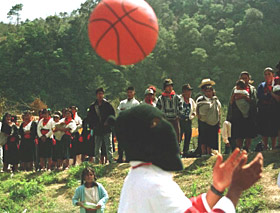 |
 |
 |
 News Around the Republic of Mexico | August 2005 News Around the Republic of Mexico | August 2005  
Hoops Sport of Choice for Mexican Rebels
 Will Weissert - Associated Press Will Weissert - Associated Press


| | At large Zapatista gatherings, teens hit the court wearing ski masks or bandannas that cover their faces. |
Carmen Patate, Mexico - It's getting dark, and there's no electricity in this corner of rebel territory - but that doesn't bother the kids. All nine keep scampering up and down the Zapatista-held village's gray-concrete basketball court, squinting to see the rainbow-colored ball as the sun slides behind the verdant hills stretching in all directions.

Soccer is king in this country, but basketball has nonetheless become the game of choice for many in southern Mexico's isolated, mountain communities, where largely Indian populations do not relate to many aspects of the outside world.

It is played inside and out of the strongholds of the armed, ski-masked Zapatistas in Chiapas, on the border with Guatemala, and is also popular in the nearby states of Guerrero and Oaxaca.

"We have always played," said 17-year-old Mario, who was watching the game in Carmen Patate, a sweltering community of farmers and small-game hunters 615 miles (985 kilometers) southeast of Mexico City. "We play soccer too. But basketball is first."

This evening, none of the pint-sized players have on tennis shoes. Most are wearing mud-caked boots or sandals, but one of the taller girls is barefoot. Some play in embroidered Mayan blouses and skirts, others wear jeans and baseball caps.

Dunking is out of the question. Anyone taller than five feet, five inches tall can play center on this court and most of the shots are non-jumping heaves that air-ball well below the net-less, iron hoops.

With buckets hard to come-by, the kids keep score by ones, and the team with five players is ahead of its man-down counterpart until a half-naked infant chasing a chicken spill onto the court, interrupting play for good.

The Zapatistas emerged from the jungle and took over several towns in Chiapas in the name of Indian rights and socialism on Jan. 1, 1994.

A cease-fire took hold after only a few days, but hundreds of rebel strongholds like Carmen Patate - which the Zapatistas have renamed Javier Hernandez in honor of a local guerrilla combatant who disappeared during a battle with government soldiers in the early days of the rebellion - have survived since then without government funding.

Rebel communities are often little more than a spattering of wood-framed, metal-roofed shacks, but a basketball court can usually be found next to a simple school or medical clinic.

The Zapatistas have not forgotten soccer. Most communities have a set of soccer goals. Murals in other parts of Chiapas depict ski-masked rebels pulling off bicycle kicks. The group's colorful spokesman, Subcomandante Marcos, even recently challenged international powerhouse Inter Milan to a series of exhibition matches in Mexico and Italy.

But basketball has struck a chord with many in rebel areas. At large Zapatista gatherings, teens hit the court wearing ski masks or bandannas that cover their faces.

Regulation-size courts with 10 foot high rims are commonplace in Chiapas, where a state and federal infrastructure program built thousands of them in the 1980s. Today, they are one of the few remaining signs of government influence in Zapatista strongholds.

"It can become the soul of a community, something everyone can get behind and support," said Felipe Lopez, a researcher at UCLA's North American Integration and Development center who hails from the town of San Lucas Quiavini, in rural Oaxaca.

Lopez said that like in Chiapas, government programs built courts alongside municipal buildings in rural areas of Oaxaca - often because there was no space to carve a full-sized soccer field into hillsides.

"They say every village in Oaxaca, like Chiapas, has a basketball court," said Lopez, who noted that officials in one Oaxacan hamlet, San Pablo Macultianguis. "Sometimes there's not much else there."

The influence of thousands who have left mountain communities and migrated to the United States for higher-paying jobs have made U.S. basketball stars household names in much of Oaxaca and Guerrero, as well as parts of Chiapas not sympathetic to the Zapatistas. Money sent home to migrant towns has helped buy satellites that beam in NBA games.

Things are different in rebel territory, however. Like most of his friends, 11-year-old Gabriel Hernandez said he had never heard of Shaq or Kobe and didn't even know who Michael Jordan is. But he's a mean ball-handler with his right hand and is improving with his left.

"A team from here played in a tournament a while back in La Garrucha," Hernandez said, referring to a larger, nearby Zapatista community when asked about playing basketball professionally. "I think they could have won money there. But they lost." | 
 | |
 |



